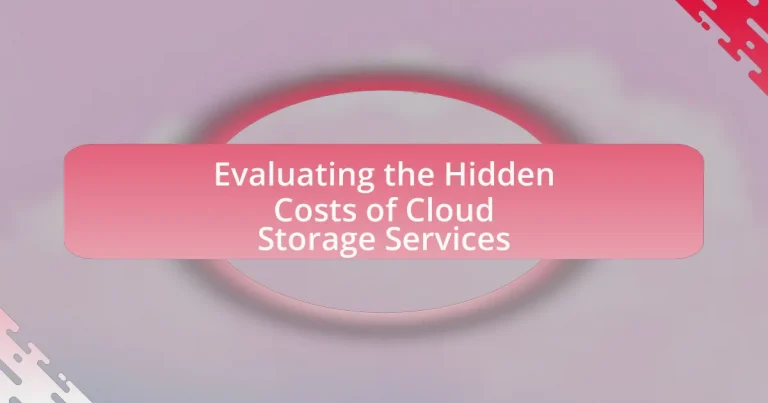The article focuses on evaluating the hidden costs associated with cloud storage services, highlighting various fees that can significantly impact overall expenses. Key hidden costs include data transfer fees, storage overage charges, and costs related to data retrieval, which can lead to budget overruns of up to 30% as reported by Gartner. The article emphasizes the importance of understanding pricing models, such as pay-as-you-go versus subscription, and the implications of tiered pricing structures. Additionally, it provides practical strategies for users to effectively assess and manage these hidden costs, ensuring informed financial decisions when selecting cloud storage solutions.
What are the Hidden Costs of Cloud Storage Services?
The hidden costs of cloud storage services include data transfer fees, storage overage charges, and costs associated with data retrieval. Data transfer fees can accumulate when moving large amounts of data in and out of the cloud, often leading to unexpected expenses. Storage overage charges occur when users exceed their allocated storage limits, resulting in additional monthly fees. Furthermore, retrieving data from cloud storage can incur costs, especially if the data is accessed frequently or if it requires special retrieval methods. According to a report by Gartner, organizations can face up to 30% higher costs than anticipated due to these hidden fees, emphasizing the importance of understanding the full pricing structure before committing to a cloud storage solution.
How do hidden costs impact overall cloud storage expenses?
Hidden costs significantly increase overall cloud storage expenses by adding unanticipated charges that users may overlook during initial pricing assessments. These costs can include fees for data retrieval, egress charges for transferring data out of the cloud, and additional charges for exceeding storage limits or using advanced features. For instance, a study by the Cloud Industry Forum found that organizations often underestimate these costs by up to 30%, leading to budget overruns. Therefore, understanding and accounting for hidden costs is crucial for accurate budgeting and financial planning in cloud storage services.
What specific hidden costs should users be aware of?
Users should be aware of several specific hidden costs associated with cloud storage services, including data retrieval fees, egress charges, and costs for additional features. Data retrieval fees can occur when users access their stored data, especially if it involves large volumes or frequent access. Egress charges apply when transferring data out of the cloud service, which can accumulate significantly over time. Additionally, costs for extra features such as enhanced security, backup solutions, or increased storage capacity can lead to unexpected expenses. According to a study by Gartner, organizations can incur up to 30% more in costs than initially anticipated due to these hidden fees, highlighting the importance of understanding the full pricing structure before committing to a cloud storage provider.
How can hidden costs vary between different cloud storage providers?
Hidden costs can vary significantly between different cloud storage providers due to differences in pricing structures, service tiers, and additional fees for features such as data retrieval, bandwidth usage, and customer support. For instance, some providers may charge for data egress, meaning users incur costs when transferring data out of the cloud, while others may include this in their pricing. Additionally, providers may have varying policies on overage charges, where exceeding storage limits can lead to unexpected fees. A study by Gartner highlights that organizations often underestimate these costs, with some providers having hidden fees that can increase total expenses by up to 30%.
Why is it important to evaluate hidden costs?
Evaluating hidden costs is crucial because it ensures a comprehensive understanding of the total expenses associated with cloud storage services. Hidden costs can significantly impact the overall budget, often leading to unexpected financial burdens. For instance, a study by Gartner indicates that organizations can incur up to 30% more in costs than initially anticipated due to overlooked fees such as data transfer charges, storage retrieval fees, and compliance costs. By assessing these hidden costs, businesses can make informed decisions, optimize their spending, and avoid budget overruns.
What are the potential consequences of overlooking hidden costs?
Overlooking hidden costs can lead to significant financial strain and budget overruns for businesses utilizing cloud storage services. When organizations fail to account for these additional expenses, such as data transfer fees, storage scaling costs, and compliance-related charges, they may experience unexpected financial burdens that disrupt their operational budgets. A study by Gartner indicates that organizations can incur up to 30% more in costs than initially projected due to unanticipated fees associated with cloud services. This miscalculation can result in reduced profitability, hindered project funding, and ultimately impact the overall financial health of the organization.
How can evaluating hidden costs lead to better financial decisions?
Evaluating hidden costs can lead to better financial decisions by providing a comprehensive understanding of total expenses associated with a service. When organizations assess hidden costs, such as data transfer fees, storage limits, and potential downtime, they can make informed choices that align with their budget and operational needs. For instance, a study by Gartner indicates that organizations often underestimate cloud costs by up to 30%, which can significantly impact overall financial planning. By identifying these hidden costs, businesses can avoid unexpected expenses and optimize their cloud storage investments, ultimately enhancing their financial performance.
What Factors Contribute to Hidden Costs in Cloud Storage?
Hidden costs in cloud storage primarily arise from factors such as data transfer fees, storage tiering, and unexpected usage spikes. Data transfer fees can accumulate when moving data in and out of the cloud, often leading to significant charges that are not initially apparent. Storage tiering involves different pricing for various levels of access and performance, which can result in higher costs if data is frequently accessed from more expensive tiers. Additionally, unexpected usage spikes, often due to increased demand or unplanned data growth, can lead to costs that exceed initial estimates. According to a study by the Cloud Industry Forum, 30% of organizations reported unanticipated costs related to data transfer and storage management, highlighting the importance of understanding these factors when evaluating cloud storage services.
How do pricing models affect hidden costs?
Pricing models significantly influence hidden costs by determining how charges are structured and what additional fees may arise. For instance, a subscription-based pricing model may initially appear cost-effective, but it can lead to hidden costs such as overage fees for exceeding storage limits or charges for data retrieval. In contrast, a pay-as-you-go model might seem straightforward, yet it can accumulate hidden costs based on usage spikes that were not anticipated. Research indicates that 30% of cloud users experience unexpected charges due to complex pricing structures, highlighting the importance of understanding pricing models to avoid hidden costs.
What are the differences between pay-as-you-go and subscription models?
Pay-as-you-go and subscription models differ primarily in their payment structure and usage flexibility. In a pay-as-you-go model, users pay only for the resources they consume, allowing for variable costs that can fluctuate based on usage patterns. This model is beneficial for users with unpredictable or sporadic needs, as it avoids upfront commitments and allows for cost control based on actual consumption. In contrast, subscription models require users to pay a fixed fee at regular intervals, typically monthly or annually, regardless of usage. This model provides predictability in budgeting and often includes additional features or services as part of the package. According to a report by Gartner, organizations often prefer subscription models for their stability and ease of budgeting, while pay-as-you-go is favored for its flexibility and potential cost savings in low-usage scenarios.
How can tiered pricing lead to unexpected charges?
Tiered pricing can lead to unexpected charges when users exceed the limits of their selected tier, resulting in additional fees. For instance, if a cloud storage service offers a plan that includes a specific amount of storage, users may inadvertently exceed that limit due to increased data usage, triggering overage charges. According to a study by Gartner, 70% of organizations experience unexpected costs in cloud services, often due to tiered pricing structures that are not clearly communicated. This lack of transparency can lead to confusion about what is included in each tier, causing users to incur costs they did not anticipate.
What role do data transfer fees play in hidden costs?
Data transfer fees significantly contribute to hidden costs in cloud storage services. These fees are often charged for moving data in and out of the cloud, which can accumulate unexpectedly, especially for businesses with high data usage. For instance, a study by the International Data Corporation found that organizations can incur up to 30% of their total cloud expenditure from data transfer fees alone. This hidden cost can lead to budget overruns and financial strain if not properly accounted for during the planning and usage phases of cloud services.
How can egress fees impact overall storage expenses?
Egress fees can significantly increase overall storage expenses by adding costs each time data is transferred out of a cloud storage service. For instance, if a business frequently accesses and retrieves large volumes of data, the cumulative egress fees can surpass the initial storage costs, leading to unexpected budget overruns. According to a report by the Cloud Industry Forum, egress fees can account for up to 30% of total cloud storage costs, particularly for organizations with high data retrieval needs. This financial impact emphasizes the importance of considering egress fees when evaluating cloud storage solutions.
What strategies can minimize data transfer costs?
To minimize data transfer costs, organizations can implement strategies such as data compression, optimizing data transfer protocols, and utilizing content delivery networks (CDNs). Data compression reduces the size of files before transmission, which directly lowers the amount of data transferred and can lead to significant cost savings. For instance, using algorithms like Gzip can reduce file sizes by up to 70%, thereby decreasing bandwidth usage.
Optimizing data transfer protocols, such as using HTTP/2 instead of HTTP/1.1, can enhance transfer efficiency and reduce costs by allowing multiple requests to be sent over a single connection, minimizing latency and improving speed.
Additionally, employing CDNs can distribute data closer to end-users, reducing the distance data must travel and consequently lowering transfer costs. Research indicates that using CDNs can reduce data transfer costs by up to 50% due to decreased latency and improved load times.
These strategies collectively contribute to minimizing data transfer costs effectively.
How Can Users Effectively Evaluate Hidden Costs?
Users can effectively evaluate hidden costs by conducting a comprehensive analysis of all potential fees associated with cloud storage services. This includes reviewing the pricing structure for data transfer, storage limits, and any additional charges for exceeding those limits. Users should also consider costs related to data retrieval, API calls, and potential penalties for early termination of contracts. According to a study by Gartner, organizations often overlook these ancillary costs, which can account for up to 30% of total cloud spending. By meticulously examining the service agreements and utilizing cost calculators provided by cloud service providers, users can gain a clearer understanding of the total cost of ownership, ensuring they account for all hidden expenses.
What tools and resources are available for cost evaluation?
Cost evaluation for cloud storage services can be conducted using various tools and resources. Key tools include cloud cost management platforms like CloudHealth, CloudCheckr, and AWS Cost Explorer, which provide detailed insights into spending patterns and resource utilization. Additionally, resources such as the Cloud Cost Management Framework by the Cloud Native Computing Foundation offer guidelines for assessing costs effectively. These tools and resources enable organizations to analyze expenses, optimize usage, and identify hidden costs associated with cloud storage services.
How can cost calculators assist in understanding potential expenses?
Cost calculators assist in understanding potential expenses by providing a detailed breakdown of costs associated with various services, including cloud storage. These tools allow users to input specific parameters, such as storage size, data transfer rates, and additional features, to generate accurate estimates of total expenses. For instance, a study by Gartner indicates that organizations can save up to 30% on cloud costs by using cost calculators to evaluate their needs and avoid over-provisioning. This data-driven approach enables users to make informed financial decisions, ensuring they understand both direct and hidden costs associated with cloud storage services.
What metrics should users track to identify hidden costs?
Users should track metrics such as data transfer costs, storage usage, API request counts, and service-level agreement (SLA) compliance to identify hidden costs in cloud storage services. Monitoring data transfer costs reveals expenses associated with moving data in and out of the cloud, which can accumulate unexpectedly. Tracking storage usage helps users understand how much space they are utilizing and whether they are over-provisioning resources. API request counts provide insight into the frequency of interactions with the cloud service, which can incur additional charges. Lastly, evaluating SLA compliance can uncover costs related to downtime or performance issues that may not be immediately apparent but affect overall expenses.
What best practices can help in assessing cloud storage costs?
To effectively assess cloud storage costs, organizations should implement a comprehensive cost analysis framework that includes evaluating usage patterns, understanding pricing models, and considering additional fees. Analyzing usage patterns helps identify storage needs and avoid over-provisioning, which can lead to unnecessary expenses. Understanding pricing models, such as pay-as-you-go versus reserved instances, allows organizations to select the most cost-effective option based on their usage. Additionally, considering potential extra charges, such as data retrieval fees or egress costs, ensures a complete understanding of total expenses. According to a report by Gartner, organizations can save up to 30% on cloud costs by optimizing their storage strategies and regularly reviewing their usage and pricing structures.
How can regular audits of cloud usage reveal hidden costs?
Regular audits of cloud usage can reveal hidden costs by identifying underutilized resources and inefficient spending patterns. These audits analyze usage data, allowing organizations to pinpoint instances where they are paying for services or capacity that they do not fully utilize. For example, a study by Gartner found that organizations can save up to 30% on cloud costs by optimizing their resource allocation through regular audits. By systematically reviewing cloud expenditures and usage metrics, companies can uncover unnecessary expenses, such as idle virtual machines or over-provisioned storage, leading to more informed financial decisions and cost savings.
What questions should users ask their cloud storage providers?
Users should ask their cloud storage providers about data security measures, pricing structures, data retrieval costs, and service level agreements. Specifically, inquiries should include:
- What encryption methods are used to protect data both in transit and at rest?
- Are there any hidden fees associated with data retrieval or exceeding storage limits?
- What is the pricing model—are costs based on usage, storage size, or a flat rate?
- What guarantees are provided regarding uptime and data availability?
These questions help users understand the true costs and security of the services offered, ensuring informed decisions.
What are the common pitfalls to avoid when evaluating costs?
Common pitfalls to avoid when evaluating costs include overlooking hidden fees, failing to account for scalability, and neglecting to consider total cost of ownership. Hidden fees, such as data transfer charges or retrieval costs, can significantly inflate the overall expense of cloud storage services. Additionally, not factoring in scalability can lead to underestimating future costs as data needs grow. Lastly, focusing solely on initial pricing without assessing the total cost of ownership, which includes maintenance and operational expenses, can result in misleading evaluations.
How can assumptions about pricing lead to unexpected expenses?
Assumptions about pricing can lead to unexpected expenses by causing users to overlook additional fees associated with cloud storage services. For instance, many providers advertise low base rates but impose extra charges for data transfer, storage overages, or premium features. According to a study by Gartner, organizations often underestimate these ancillary costs, resulting in budget overruns of up to 30%. This discrepancy occurs because users may not fully understand the pricing structure or fail to account for their actual usage patterns, leading to financial surprises.
What are the risks of not reading the fine print in contracts?
Not reading the fine print in contracts poses significant risks, including unexpected fees, unfavorable terms, and loss of rights. These risks arise because contracts often contain critical details about costs, obligations, and limitations that can affect the overall agreement. For instance, a study by the Consumer Financial Protection Bureau found that consumers frequently encounter hidden fees in service contracts, which can lead to financial strain and dissatisfaction. Additionally, failing to understand cancellation policies or data usage limits can result in penalties or service interruptions, further emphasizing the importance of thorough review.
What practical tips can help users manage hidden costs in cloud storage?
To manage hidden costs in cloud storage, users should regularly monitor their usage and billing statements. By keeping track of data storage, transfer rates, and additional features, users can identify unexpected charges. Implementing budget alerts can also help users stay informed about spending limits. Additionally, selecting the right pricing model—such as pay-as-you-go versus flat-rate—can prevent overpayment for unused services. Research indicates that 30% of cloud users experience unexpected costs due to lack of monitoring, highlighting the importance of proactive management.


